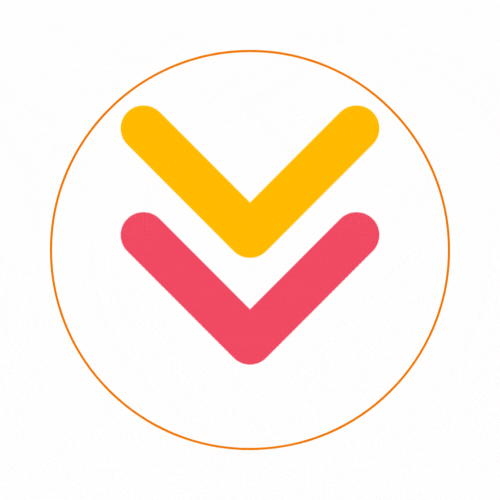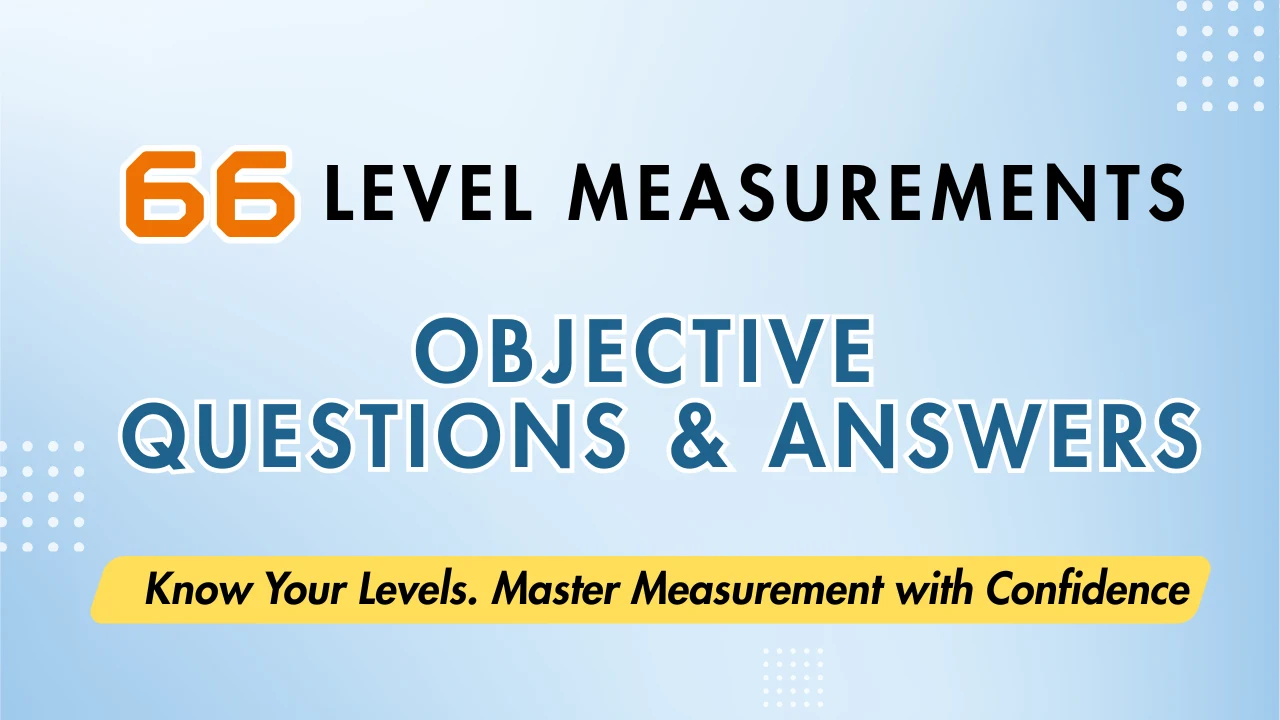Level measurement is a key part of process industries, helping operators maintain safe & efficient operations. From storage tanks to boiler drums, accurate level monitoring ensures product quality, safety, and process reliability.
There are many methods available which includes float gauges, displacers, differential pressure transmitters, capacitance probes, ultrasonic sensors, radar systems, and even nuclear gauges for extreme conditions.
In this blog, I have compiled 66 objective questions with answers on level measurement. These MCQs cover both basics and advanced concepts, making them useful for students, engineers, and professionals preparing for exams, interviews, or refreshing their knowledge.

Level Measurement - Questions & Answers
1. Level measurement in process industries refers to:
a) Measuring pressure of liquid
b) Measuring temperature of liquid
c) Measuring height of liquid/solid in a vessel
d) Measuring volume directly
Answer: c
2. A sight glass level indicator works on:
a) Hydrostatic pressure
b) Direct visual indication
c) Capacitance
d) Ultrasonic reflection
Answer: b
3. The simplest method of level measurement is:
a) Float and tape gauge
b) Ultrasonic sensor
c) Radar level transmitter
d) Differential pressure transmitter
Answer: a
4. A float-type level gauge works on the principle of:
a) Archimedes’ principle (buoyancy)
b) Capacitance change
c) Microwave frequency shift
d) Doppler effect
Answer: a
5. A displacer level transmitter measures level by:
a) Volume displacement causing buoyant force
b) Direct height of liquid
c) Capacitance variation
d) Ultrasonic pulse echo
Answer: a
6. Differential pressure level transmitters measure:
a) Direct mass of liquid
b) Hydrostatic pressure proportional to liquid height
c) Density only
d) Vibration frequency
Answer: b
7. Which of the following can measure both liquid and solid level?
a) Sight glass
b) Ultrasonic level transmitter
c) Float gauge
d) Bubbler system
Answer: b
8. In a bubbler level system, level is measured by:
a) Air flow rate
b) Back pressure proportional to liquid head
c) Direct liquid displacement
d) Capacitance variation
Answer: b
9. Capacitance level measurement works by:
a) Change in capacitance between probe and tank wall with liquid level
b) Air flow rate change
c) Buoyant force variation
d) Microwave reflection
Answer: a
10. Ultrasonic level transmitters work on:
a) Sound velocity in solids
b) Time-of-flight of sound waves in air above liquid
c) Capacitance change
d) Buoyancy
Answer: b
11. Radar level measurement is based on:
a) Reflection of electromagnetic waves (microwaves) from liquid/solid surface
b) Pressure difference
c) Capacitance variation
d) Buoyancy
Answer: a
12. Which level measurement technique is suitable for corrosive liquids?
a) Sight glass
b) Capacitance probe
c) Non-contact radar or ultrasonic
d) Float gauge
Answer: c
13. A gamma-ray (nuclear) level gauge works on:
a) Density and attenuation of radiation passing through vessel
b) Buoyant force
c) Capacitance
d) Microwave reflection
Answer: a
14. Which method is most suitable for slurry level measurement?
a) Float gauge
b) Radar or ultrasonic
c) Bubbler system
d) Turbine meter
Answer: b
15. In capacitive level measurement, dielectric constant of the liquid affects:
a) Capacitance value and sensitivity
b) Pressure reading
c) Temperature response
d) Signal frequency only
Answer: a
16. Which instrument is commonly used for tank inventory measurement?
a) Sight glass
b) Servo level gauge
c) Float switch
d) Orifice plate
Answer: b
17. Magnetic level gauges operate by:
a) Magnetic coupling between float and external indicator
b) Capacitance variation
c) Gamma radiation
d) Pressure difference
Answer: a
18. Which of the following is NOT a non-contact level measurement method?
a) Radar
b) Ultrasonic
c) Gamma-ray
d) Float gauge
Answer: d
19. Foam formation in tanks affects accuracy of:
a) Ultrasonic level transmitters
b) Radar level transmitters
c) Displacer gauges
d) Capacitance probes
Answer: a
20. A bubbler system is most suitable for:
a) Open tanks and corrosive liquids
b) High-pressure boilers
c) Vacuum chambers
d) Transparent tanks
Answer: a
21. A float switch is mainly used for:
a) Continuous level measurement
b) On/off control (level detection)
c) Mass flow measurement
d) Density measurement
Answer: b
22. Radar level transmitters are classified as:
a) Guided wave and non-contact types
b) Float and displacer types
c) Ultrasonic and capacitance types
d) Servo and differential pressure types
Answer: a
23. A displacer level transmitter output depends on:
a) Displacer length only
b) Buoyant force proportional to liquid level
c) Pressure only
d) Capacitance change
Answer: b
24. Capacitance level measurement is not suitable for:
a) Conductive liquids
b) Non-conductive liquids
c) Sticky or coating liquids
d) Slurries
Answer: c
25. In a bubbler system, the density of the liquid must be known because:
a) Bubbles affect calibration
b) Back pressure is proportional to ρ × h
c) Density is independent of pressure
d) It affects air flow
Answer: b
26. Ultrasonic level transmitters face limitations due to:
a) Vapors, foam, and dust interfering with sound waves
b) Temperature only
c) Pressure only
d) Corrosive nature of liquids
Answer: a
27. Which is more accurate for solids level measurement?
a) Float switch
b) Guided wave radar
c) Sight glass
d) Bubbler
Answer: b
28. A nuclear level gauge is mainly used when:
a) Vessel is pressurized, corrosive, or opaque
b) Liquid is conductive
c) Cheap installation is required
d) Foam-free surface exists
Answer: a
29. Servo level gauges are commonly used for:
a) Fuel storage tanks and custody transfer
b) Boiler drum level
c) Slurry measurement
d) Foam detection
Answer: a
30. Which method of level measurement is intrusive?
a) Radar
b) Ultrasonic
c) Capacitance probe
d) Gamma-ray
Answer: c
31. Guided wave radar can measure:
a) Liquids only
b) Solids only
c) Both liquids and solids
d) Gas only
Answer: c
32. Hydrostatic level measurement uses:
a) Pressure transmitter at bottom of tank
b) Float gauge
c) Gamma radiation
d) Capacitance probe
Answer: a
33. Foam layers on liquid surfaces may cause errors in:
a) Ultrasonic and capacitance methods
b) Radar (non-contact) methods
c) Displacer methods
d) Servo methods
Answer: a
34. Which of the following methods is non-intrusive?
a) Radar
b) Ultrasonic
c) Gamma-ray
d) All of the above
Answer: d
35. Float level switches are best suited for:
a) Slurries and foamy liquids
b) Clean liquids in open or closed tanks
c) Very high-temperature measurement
d) Solid powders
Answer: b
36. A capacitance level sensor measures:
a) Pressure
b) Dielectric constant changes due to liquid level
c) Density only
d) Flow rate
Answer: b
37. The major drawback of sight glass level gauges is:
a) Direct visibility required
b) Cannot handle pressure
c) Fragility and leakage risk
d) All of the above
Answer: d
38. Which method is most suitable for continuous high-temperature liquid level measurement?
a) Float switch
b) Radar (non-contact)
c) Ultrasonic
d) Capacitance probe
Answer: b
39. In boiler drum level measurement, the common method used is:
a) Sight glass
b) Differential pressure transmitter with density compensation
c) Ultrasonic radar
d) Float switch
Answer: b
40. Magnetic float level switches use:
a) Magnetic coupling between float and reed switches
b) Gamma radiation
c) Sound waves
d) Servo mechanism
Answer: a
41. Which level measurement method is best for powdered solids like cement?
a) Float gauge
b) Radar (non-contact)
c) Ultrasonic
d) Capacitance probe
Answer: b
42. The main limitation of capacitance level transmitters in slurries is:
a) Temperature sensitivity
b) Coating of probe changes capacitance
c) High cost
d) Density variation
Answer: b
43. Which level measuring device can also provide density measurement?
a) Radar
b) Coriolis
c) Differential pressure transmitter
d) Sight glass
Answer: c
44. A guided wave radar probe inside a tank is generally made of:
a) Glass
b) Metallic rod or cable
c) Plastic
d) Ceramic
Answer: b
45. A servo level gauge operates by:
a) Moving a displacer attached to a motor until buoyant force is balanced
b) Measuring pressure difference
c) Capacitance variation
d) Ultrasonic time of flight
Answer: a
46. Which non-contact method is least affected by temperature, vapor, or pressure?
a) Ultrasonic
b) Radar
c) Capacitance
d) Float gauge
Answer: b
47. Which method is suitable for measuring interface level (oil-water separation)?
a) Displacer
b) Capacitance probe
c) Guided wave radar
d) All of the above
Answer: d
48. In hydrostatic level measurement, compensation is required for:
a) Liquid density changes with temperature
b) Foam
c) Vibration
d) Tank diameter
Answer: a
49. Transparent tube sight glass gauges work best when:
a) Fluid is opaque
b) Fluid is clear and tank is not pressurized
c) Tank is buried underground
d) Used for solids
Answer: b
50. Which of the following can directly measure the level of molten metal?
a) Capacitance probe
b) Radar
c) Laser level measurement
d) Ultrasonic
Answer: c
51. Which level transmitter has no moving parts and requires no contact with liquid?
a) Radar (non-contact)
b) Float gauge
c) Displacer transmitter
d) Capacitance probe
Answer: a
52. The bubbler system requires a constant:
a) Supply of purge air or gas
b) Electromagnetic field
c) Ultrasonic signal
d) Magnetic field
Answer: a
53. For tall distillation columns, the preferred method of level measurement is:
a) Displacer gauge
b) Differential pressure transmitter with remote seals
c) Ultrasonic level meter
d) Magnetic float
Answer: b
54. Foam in tanks causes maximum error in:
a) Ultrasonic transmitters
b) Radar transmitters
c) Displacer transmitters
d) Hydrostatic transmitters
Answer: a
55. Which level measurement device works on “time of flight” principle?
a) Radar and ultrasonic transmitters
b) Float gauge
c) Capacitance probe
d) Sight glass
Answer: a
56. Magnetic level indicators are widely used in:
a) Boilers and pressurized vessels
b) Open tanks
c) Slurries
d) Transparent liquids only
Answer: a
57. The sensitivity of a capacitance level sensor depends on:
a) Dielectric constant difference between liquid and vapor phase
b) Pressure
c) Temperature
d) Flow velocity
Answer: a
58. Nuclear level gauges require:
a) Regulatory approval and radiation shielding
b) No maintenance
c) High pressure tanks only
d) Contact with liquid
Answer: a
59. Which instrument can measure continuous level of granular solids like grains?
a) Guided wave radar
b) Sight glass
c) Float switch
d) Ultrasonic
Answer: a
60. Differential pressure transmitters with remote seals are useful when:
a) Fluid is corrosive or slurry
b) Vessel is at very high temperature
c) Direct contact must be avoided
d) All of the above
Answer: d
61. Which type of radar level transmitter is best for long-range measurement?
a) 6 GHz radar
b) 26 GHz radar
c) 80 GHz radar
d) Ultrasonic
Answer: c
62. In a bubbler system, purge gas is usually:
a) Nitrogen or clean air
b) Steam
c) Carbon dioxide
d) Process gas
Answer: a
63. Which method gives both point and continuous level measurement in one device?
a) Guided wave radar
b) Float switch
c) Ultrasonic
d) Sight glass
Answer: a
64. Radar level transmitters are more accurate than ultrasonic because:
a) Radar waves are not affected by temperature, pressure, or vapor
b) Radar is cheaper
c) Radar uses sound velocity
d) Radar requires no power
Answer: a
65. The principle of hydrostatic level measurement is given by:
a) P = ρgh
b) P = F/A
c) P = VIt
d) P = nRT
Answer: a
66. Which level measurement method is most expensive but reliable in extreme conditions?
a) Float switch
b) Gamma-ray (nuclear) gauge
c) Ultrasonic sensor
d) Capacitance probe
Answer: b
I hope you like above blog. There is no cost associated in sharing the article in your social media. Thanks for reading!! Happy Learning!!



